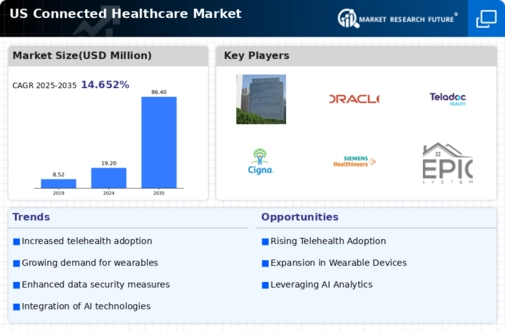Increased Focus on Patient-Centric Care
The connected healthcare market is witnessing a shift towards patient-centric care models, emphasizing the importance of patient engagement and satisfaction. Healthcare providers are increasingly adopting technologies that empower patients to take an active role in their health management. This trend is reflected in the growing use of mobile health applications and telehealth services, which facilitate communication between patients and providers. Research indicates that patient engagement can lead to improved health outcomes and reduced healthcare costs. As a result, the connected healthcare market is evolving to prioritize tools and services that enhance the patient experience, ultimately fostering a more collaborative healthcare environment.
Rising Demand for Remote Patient Monitoring
The connected healthcare market is experiencing a notable increase in demand for remote patient monitoring solutions, driven by the need for continuous health tracking and management, particularly for chronic conditions. According to recent data, the remote patient monitoring segment is projected to grow at a CAGR of approximately 25% over the next five years. Patients and healthcare providers are increasingly recognizing the benefits of real-time data collection and analysis, which can lead to timely interventions and improved health outcomes. The connected healthcare market is thus evolving to accommodate these needs, with innovative technologies enabling seamless communication between patients and providers. As healthcare systems strive to enhance patient engagement and reduce hospital readmissions, the integration of remote monitoring tools is likely to play a pivotal role in shaping the future of healthcare delivery.
Growing Investment in Health IT Infrastructure
Investment in health information technology (IT) infrastructure is a key driver of growth in the connected healthcare market. Healthcare organizations are increasingly allocating resources to upgrade their IT systems, ensuring they can support advanced digital health solutions. This trend is underscored by the fact that health IT spending in the US is projected to exceed $200 billion by 2025. Enhanced IT infrastructure facilitates better data management, interoperability, and security, which are essential for the effective implementation of connected healthcare solutions. As healthcare providers recognize the importance of robust IT systems, the connected healthcare market is poised for substantial growth, enabling more efficient and effective healthcare delivery.
Regulatory Support for Digital Health Innovations
Regulatory bodies in the US are increasingly supporting innovations in the connected healthcare market through favorable policies and guidelines. This support is crucial for the development and adoption of digital health technologies, including telehealth and mobile health applications. Recent initiatives aim to streamline the approval process for digital health solutions, thereby encouraging investment and innovation in the sector. The FDA has introduced frameworks to expedite the review of software-based medical devices, which is expected to enhance the market landscape. As regulatory support continues to grow, the connected healthcare market is likely to expand, fostering an environment conducive to technological advancements and improved patient care.
Integration of Artificial Intelligence in Healthcare
The integration of artificial intelligence (AI) into the connected healthcare market is transforming the way healthcare services are delivered. AI technologies are being utilized for predictive analytics, personalized treatment plans, and enhanced diagnostic accuracy. The market for AI in healthcare is expected to reach approximately $36 billion by 2025, indicating a robust growth trajectory. AI applications can analyze vast amounts of data, enabling healthcare professionals to make informed decisions quickly. This capability is particularly valuable in emergency situations where timely interventions can save lives. As healthcare providers increasingly adopt AI-driven solutions, the connected healthcare market is likely to witness significant advancements in operational efficiency and patient care quality.





















Leave a Comment